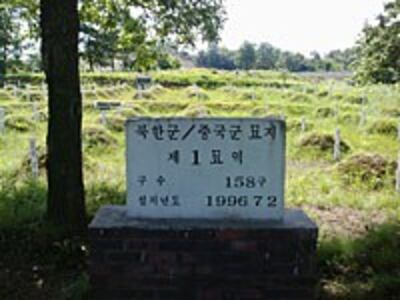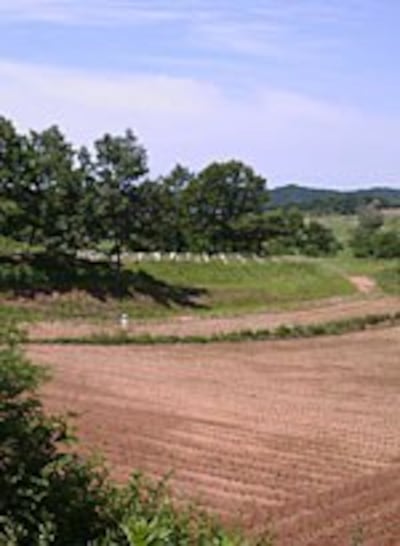SEOUL—About an hour’s drive southward down South Korea’s “Unification Highway” from the capital lies the unremarkable village of Paju, amid typical Korean farmland, just below the 38th parallel that divides the capitalist South from the Stalinist North.
Up on a hillside, amid tall grasses and inaccessible by any visible road or path, is a stone marker that reads “North Korean and Chinese Military Cemetery No. 1.”
Here lie the enemy, a disturbing reminder that the Korean War (1950-53) never formally ended.
“This is a testament to the tragedy and sorrow embedded in modern Korean history,” North Korean defector Kim Tae San said in an interview alongside the graves of 352 North Koreans and 84 Chinese mainly killed in action during the Korean War.
"They were not evil people. They were simply acting under orders, and now they all lie here, forgotten by all."<br/>Kim Tae San
The white wooden stakes marking the graves at Paju are about three feet tall, but only about 20 of them display the name and rank of the fallen. The others are simply marked “Unknown.”
Captured agents
Most of the “unknowns” were killed in action. But some of the dead still have stories to tell. These include North Korean agents intercepted on missions deep inside South Korean territory.
One group of 31 men, now buried here, entered the South on Jan. 21, 1968, disguised as South Korean soldiers, on a suicide mission to assassinate then South Korean President Park Chung-hee.

They got as far as the security perimeter around the South Korean presidential palace, en route to assassinate the president and other government officials, before falling in a gun battle with police on the streets of Seoul.
“Of the 31, one man was captured and has found a new home in South Korea. The North Koreans would label him a traitor,” according to Kim Tae San, who recently learned that Kim Shin Jo had survived and become a Protestant minister after arriving in the South.
“His brothers in arms are buried here. They breathed their last here, never able to return to their families in the North, and their poor restless souls must be still wandering around, all alone and forgotten, trying to find peace,” he said.
But while 30 headstones mark the resting places of that suicide squad, suicide squad survivor Kim Shin Jo said in a recent interview that only 29 were actually killed.
Battle of the Naktong Bulge
“Many years have gone by since that fateful day,” he said. “Now I feel I can open up and speak freely about the North Korean agent who got away.”
The South Korean government has never confirmed that one of the 31 agents got away and claims that a body found floating in a river a month after the raid in 1968 was the missing member of the suicide mission.

Buried on the same hillside are 27 North Korean soldiers killed in the Battle of the Naktong Bulge, and the crew of a North Korean submarine sent on a suicide mission against a target in the South in 1998.
About the June 24, 1998 incident, Kim Tae San said: “These people died in peacetime. I am a North Korean, and I do feel guilty about this.”
“They were not evil people. They were simply acting under orders, and now they all lie here, forgotten by all,” he said. “Politicians used them for their political goals, against other Koreans.”
North Korean defector Kim Choon-Ae also traveled to the “Enemy Cemetery.” Her father-in-law was missing at the battle of the Naktong Bulge.
Unknown soldiers
“It’s been over 50 years, and his remains have never been recovered,” she said. “I am experiencing emotions I have never felt before here at Paju.”
“Maybe he is one of the unknown North Korean solders buried here. My heart is heavy. This is an indescribable feeling,” she said.
All the graves at Paju face north, toward the hometowns of those who are buried here.
“It seems to me that the South Koreans did not just thoughtlessly lay them to rest here,” Kim Choon-Ae said. “This place was carefully chosen, as North Korea is just a stone throw’s away.”
“Graves in South Korea face South, but these graves face North, toward the hometowns of these fallen North Koreans. It truly takes something special for one to pay this kind of respect to his fallen enemies and bury them in such fashion,” she said.
Kim Tae San said he regretted not having brought flowers or rice wine to make an offering to the dead, who include North Korean agent Kim Sun-gil, who helped to blow up Korean Airlines Flight 858 from Bahrain to Seoul in 1987 in a bid to sabotage the 1988 Seoul Olympics.
“I can’t help but weep by their graves,” he said. “They never had a chance to return to their hometowns, to their families and parents longing for them back home. Their families and friends have no idea whether they’re dead or alive, or where their graves are.”
Original reporting in Korean by Sung-woo Park. Korean service director: Kwang-Chool Lee. Translated and researched by Grigore Scarlatoiu. Written for the Web in English by Luisetta Mudie. Edited by Sarah Jackson-Han.
